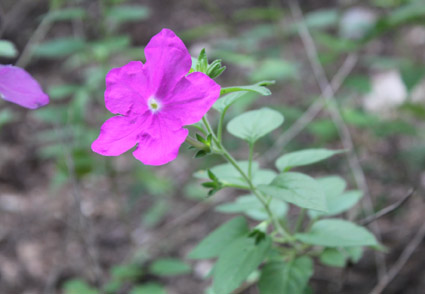Abstract
Hunzikeria is a petunioid genus of Solanaceae that includes three species. The genus presents a disjunct distribution between South and North America. Hunzikeria coulteri and H. texana occur in North America, while H. steyermarkiana is reported from Venezuela. During botanical explorations in western Mexico, we found a population of Hunzikeria that differed from the three known species. Believing that we had found an undescribed species, we collected samples and prepared herbarium vouchers. We compared our material with morphological descriptions and herbarium specimens of the other species in the genus. Our results indicate that we discovered a new species, named here as Hunzikeria gypsophila. This new species is a microendemic gypsophyte that inhabits two gypsum ravines in southern Jalisco, Mexico. Hunzikeria gypsophila differs from the other three species in being a subshrub of taller stature and having petiolate leaves, wider leaf blades, longer corolla tubes, and broader corolla limbs. The most morphologically similar species is H. steyermarkiana, which differs in having anthers of equal size, while all the North American species have didynamous anthers. Hunzikeria shows a clear affinity for sedimentary soils and H. gypsophila is the first species recorded on gypsum. The gypsum outcrops of western Mexico have a unique flora, which likely became isolated due to volcanic activity. With this new find, Hunzikeria comprises four species. We provide a key for their identification and a distribution map for Mexico.
References
Acevedo-Rosas, R. & Cházaro, M.J. (2003) A new species and a nomenclatural change in Graptopetalum (Crassulaceae). Novon 13: 377–380. https://doi.org/10.2307/3393365
Bachman, S., Moat, J., Hill, A.W., de la Torre, J. & Scott, B. (2011) Supporting Red List threat assessments with GeoCAT: geospatial conservation assessment tool. ZooKeys 150: 117–126. https://doi.org/10.3897/zookeys.150.2109
Barboza, G.E., Hunziker, A.T., Bernardello, G., Cocucci, A.A., Moscone, A.E., Carrizo-García, C., Fuentes, V., Dillon, M.O., Bittrich, V., Cosa, M.T., Subils, R., Romanutti, A., Arroyo, S. & Anton, A. (2016) Solanaceae. In: Kubitzki, K. (Ed.) The families and genera of vascular plants: volume 14. Springer, Switzerland, pp. 295–357. https://doi.org/10.1007/978-3-319-28534-4_29
Bentham, G. (1875) Revision of the Suborder Mimoseae. Transactions of the Linnean Society of London 30: 335–668.
Britton, N.L. & Rose, J.N. (1928) North American Flora 23: 1–76.
Campa, M.F. & Coney, P.J. (1982) Tectono-stratigraphic terranes and mineral resource distributions in Mexico. Canadian Journal of Earth Sciences 20: 1040–1051.
D’Arcy, W.G. (1976) New names and taxa: Solanaceae. Phytologia 34: 283.
D’Arcy, W.G. (1978) A preliminary synopsis of Salpiglossis and other Cestreae (Solanaceae). Annals of the Missouri Botanical Garden 65: 698–724. https://doi.org/10.2307/2398869
Davis, C.C. (2023) The herbarium of the future. Trends in Ecology and Evolution 38: 412–423. https://doi.org/10.1016/j.tree.2022.11.015
Dunal, M.F. (1852) Solanaceae. In: De Candolle, A.C. (ed.) Prodromus Systematis Naturalis Regni Vegetabilis 13: 1–690.
Dupin, J., Matzke, N.J., Särkinen, T., Knapp, S., Olmstead, R.G., Bohs, L. & Smith, S.D. (2017) Bayesian estimation of the global biogeographical history of the Solanaceae. Journal of Biogeography 44: 887–899. https://doi.org/10.1111/jbi.12898
Engler, A. (1880) Botanische Jahrbücher für Systematik, Pflanzengeschichte und Pflanzengeographie. Verlag von Wilhelm Engelmann, Leipzig, 552 pp.
Gray, A. (1877) Characters of some little-known or new genera of plants. Proceedings of the Academy of Arts and Sciences 95: 157–165.
Harker, M., Hernández-López, L. & Muñiz-Castro, M.A. (2021) Flora del bosque tropical caducifolio en una zona con suelos yesosos y calcáreos de Colima, México. Acta Botanica Mexicana 128: e1818. https://doi.org/10.21829/abm128.2021.1818
Huérfano, A., Fedón, I. & Mostacero, J. (2020) Libro Rojo de la Flora Venezolana, segunda edición. Instituto Experimental Jardín Botánico Dr. Tobías Lasser, Caracas, Venezuela, 495 pp.
Hunziker, A.T. (2001) The genera of Solanaceae. A. R. G. Gantner Verlag K. G., Germany, 500 pp.
Hunziker, A.T. & Subils, R. (1986) Estudios sobre Solanaceae. XXII. Un nuevo género en la tribu Salpiglossidae. Kurtziana 18: 121–131.
IUCN. (2022) Guidelines for Using the IUCN Red List Categories and Criteria. Version 15. Standards and Petitions Committee, 116 pp. Available from: https://www.iucnredlist.org/resources/redlistguidelines (accessed: October 2022).
Kunth, C.S. (1825) Nova genera et species plantarum 7. Lutetiae Parisiorum, Paris, 506 pp.
La Llave, P. & Lexarza, J.J.M. (1825) Novorum Vegetabilium Descriptiones: fasciculus II. Apud Martinum Riveram, Mexico, 56 pp.
Martínez, M., Vargas-Ponce, O., Rodríguez, A., Chiang, F. & Ocegueda, S. (2017) Solanaceae family in Mexico. Botanical Sciences 95: 131–145. https://doi.org/10.17129/botsci.658
Martínez, M., Montero, J.C., Dean, E.A., Bye, R., Luna-Cavazos, M., Medina, J.M. & Rzedowski, J. (2020) Flora del Bajío y regiones adyacentes: fascículo 218: familia Solanaceae I: géneros Acnistus-Witheringia, (excepto Solanum). Instituto de Ecología A. C., Michoacán, 231 pp.
Mastretta-Yanes, A., Moreno-Letelier, A., Piñero, D., Jorgensen, T.H. & Emerson, B.C. (2015) Biodiversity in the Mexican highlands and the interaction of geology, geography and climate within the Trans-Mexican Volcanic Belt. Journal of Biogeography 42: 1586–1600. https://doi.org/10.1111/jbi.12546
McVaugh, R. & Mickel, J.T. (1963) Notes on Pinguicula, sect. Orcheosanthus. Britonia 15: 134–140. https://doi.org/10.2307/2805399
Olmstead, R.G., Bohs, L., Migid, H.A., Santiago-Valentin, E., Garcia, V.F. & Collier, S.M. (2008) A molecular phylogeny of the Solanaceae. TAXON 57: 1159–1181. https://doi.org/10.1002/tax.574010
Olmstead, R.G. (2013) Phylogeny and biogeography in Solanaceae, Verbenaceae and Bignoniaceae: a comparison of continental and intercontinental diversification patterns. Botanical Journal of the Linnean Society 171: 80–102. https://doi.org/10.1111/j.1095-8339.2012.01306.x
Ortiz-Brunel, J.P., Ochoterena, H., Moore, M.J., Aragón-Parada, J., Flores, J., Munguía-Lino, G., Rodríguez, A., Salinas-Rodríguez, M.M. & Flores-Olvera, H. (2023) Patterns of richness and endemism in the gypsicolous flora of Mexico. Diversity 15: 522. https://doi.org/10.3390/d15040522
QGIS Development Team. (2018) QGIS Geographic Information System. Open-Source Geospatial Foundation Project. Available at: https://www.qgis.org/ (accessed 16 June 2023).
Raven, P.H. & Axelrod, D.I. (1974) Angiosperm biogeography and past continental movements. Annals of the Missouri Botanical Garden 61: 539–673.
Särkinen, T., Bohs, L., Olmstead, R.G. & Knapp, S. (2013) A phylogenetic framework for evolutionary study of the nightshades (Solanaceae): a dated 1000-tip tree. BMC Evolutionary Biology 13: 214. https://doi.org/10.1186/1471-2148-13-214
Thiers, B. (2022) Index Herbariorum: A global directory of public herbaria and associated staff. New York Botanical Garden’s Virtual Herbarium. Available at: https://sweetgum.nybg.org/science/ih/ (accessed 21 November 2022).
Torrey, J. (1859) Botany. In: Emory, W.H. (Ed.) Report on the United States and Mexican Boundary. A.O.P. Nicholson, Washington, pp. 27–270.
Villaseñor, J.L. (2016) Checklist of the native vascular plants of Mexico. Revista Mexicana de Biodiversidad 87: 559–902. https://doi.org/10.1016/j.rmb.2016.06.017


